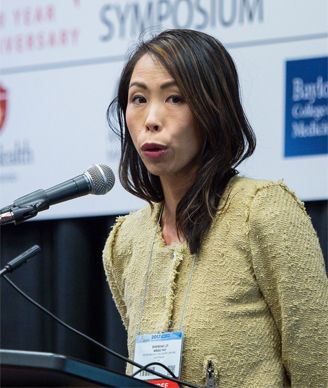Can Immunotherapy in HER2+ Breast Cancer Suppress Trastuzumab Resistance?
The combination of pembrolizumab and trastuzumab showed promising clinical benefit in patients with trastuzumab-resistant HER2-positive advanced breast cancer who express PD-L1, according to a new study.
Sherene Loi, MD, PhD, presenting the results. Photo by © MedMeetingImages/Todd Buchanan 2017

The combination of pembrolizumab and trastuzumab showed promising clinical benefit in patients with trastuzumab-resistant HER2-positive advanced breast cancer who express PD-L1, according to a new study.
“We believe that immune evasion is part of the biological resistance to trastuzumab in patients with this disease,” said Sherene Loi, MD, PhD, of the Peter MacCallum Cancer Centre in Melbourne, Australia, according to a press release. She presented results of the PANACEA study testing whether immunotherapy might help suppress that resistance at the 2017 San Antonio Breast Cancer Symposium (SABCS), held December 5–9.
The study had a phase Ib and a phase II portion, including a total of 58 patients with HER2-positive breast cancer. Of those, the 6 phase Ib patients were PD-L1–positive, 40 phase II patients were PD-L1–positive, and 12 phase II patients were PD-L1–negative. Among all patients, the median age was 50.5 years, 56.9% were estrogen receptor–negative, and all had previously received trastuzumab.
Among all PD-L1–positive patients in both phase I and phase II cohorts, the objective response rate was 15.2%, and the disease control rate was 24%. There were two complete responses seen, along with five partial responses; seven patients had stable disease.
The median duration of disease control in the PD-L1–positive patients was 11.1 months, and the median duration of response was 3.5 months. Five patients (10.8%) still had no progression at the time the study was reported. The median overall survival (OS) was 16.1 months in PD-L1–positive patients, and 7 months in PD-L1–negative patients; the 12-month OS rate in PD-L1–positive patients was 65%, compared with 12% in PD-L1–negative patients.
The most common adverse events (AEs) that were at least possibly related to study therapy included fatigue, diarrhea, arthralgia, headache, and nausea. Immune-related AEs occurred in 19% of patients, and grade 3 or higher immune-related AEs occurred in 10.3%.
Patients with higher levels of stromal tumor-infiltration lymphocytes (sTIL) at baseline had better response and disease control rates. This could be used as a predictive marker: 41% of the study cohort had sTIL ≥ 5%, and among those who did the objective response rate was 39% compared to 5% in those with sTIL levels < 5%. The disease control rate among those with higher sTIL levels was 47%, compared with 5% in those with levels < 5%.
“For responders, this combination offers durable control without chemotherapy” in patients who are resistant to trastuzumab, Loi said. She added that future trials of immunotherapy in the metastatic HER2-positive setting should focus on combinations with anti-HER2 therapies, especially in low-TIL patients.